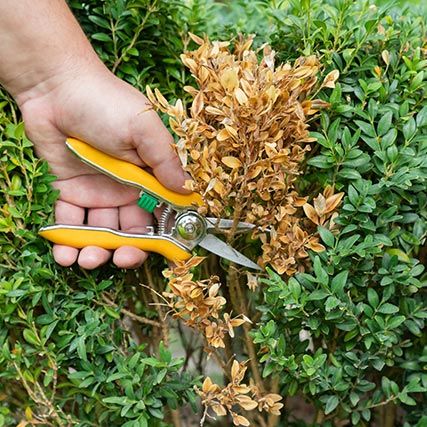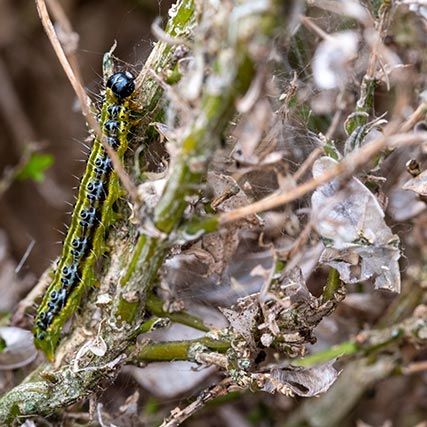Box hedges are a popular choice for garden enthusiasts, valued for their lush green foliage and ability to be shaped into intricate designs.
However, as with any plant, box hedges can encounter a variety of challenges, including fungal diseases, pests, and environmental factors.
Proper care, maintenance, and prevention measures are essential to keep these attractive hedges healthy and thriving.
In this comprehensive guide, we’ll explore common problems with box hedge plants, how to identify pests and diseases, and the best methods for treating and preventing these issues.
A vital first step in maintaining a healthy box hedge is understanding the various problems that can affect its health and appearance.
Some of the most common issues include fungal diseases, pests, and environmental factors.
We’ll examine each of these categories and provide guidance on their identification, enabling you to respond efficiently and decisively when confronted with these challenges.
Box Blight is a fungal disease that presents with brown patches on leaves, black streaks on stems, and leaf loss. It’s caused by two genetic types of fungus, Cylindrocladium buxicola.
Volutella Blight, on the other hand, does not cause black streaks and leaf loss. Instead, it exhibits pink fungal spore masses under the leaves, differentiating it from Box Blight. Both diseases can wreak havoc on your box hedges if not identified and treated promptly.
A key factor in treating and preventing these diseases is knowing their differences. Sustained surveillance of your box hedges for infection signs allows for timely intervention, mitigating the diseases’ impact and safeguarding your hedge’s health.

The box hedge caterpillar, also known as the box tree caterpillar, is another common problem for box hedges. These pests are the larvae of the box tree moth (Cydalima perspectalis) and can cause significant damage to your hedges.
Signs of infestation include widespread browning and loss of leaves, as well as webbing across the foliage. Left unchecked, these caterpillars can defoliate and potentially kill your hedge.
Similar to fungal diseases, spotting and addressing a box hedge caterpillar infestation early on is pivotal in its management.
Consistent checks on your hedge can aid in recognising and dealing with this issue before it escalates into a serious risk to your plants, potentially causing bare patches.

Environmental factors can also impact the health of your box hedges. Frost damage can lead to discolored and brittle leaves, and in extreme cases, plant death. Inadequate growing conditions, such as poor soil quality or insufficient sunlight, can result in stunted growth, yellowing leaves, and plant mortality.
Guaranteeing that your box hedges are well-cared for and shielded from environmental stressors helps keep them healthy and vigorous.
This encompasses offering ideal soil conditions, sufficient sunlight, and safeguarding them from frost damage.

Upon identifying the issue troubling your box hedge, immediate action is necessary to rectify and control the problem. A range of treatment options are available depending on the cause, spanning from tackling fungal diseases and pests to enhancing environmental conditions.
We’ll examine these treatments with greater detail.
While there is no cure for Box Blight, it can be managed through a combination of methods. Here are some steps you can take:
Prune infected branches and sterilise your equipment afterwards.
Apply relevant fungicides, such as tebuconazole and tebuconazole with trifloxystrobin, to help control the disease.
Enhance air circulation around your box plants.
Promptly dispose of any infected debris to limit the spread of Box Blight.
Implementing these treatment methods can help manage Box Blight and reduce its effect on your box hedging. It’s worth recalling that timely detection and intervention are fundamental in successfully dealing with this fungal disease.
For box hedge caterpillar infestations, biological controls and insecticides can be effective treatment options.
Releasing beneficial insects, such as ladybugs, lacewings, and parasitic wasps, can help keep caterpillar populations under control.
Insecticides like Xentari can also be used to manage these pests.
Applying these treatment methods can safeguard your box hedges from caterpillar damage and retain their health.
Remember, frequent checks and early intervention are essential to ward off severe infestations.
Addressing environmental factors that contribute to box hedge problems is another critical aspect of treatment. Improving soil conditions, for example, can be achieved through the addition of organic matter like compost or manure to optimize drainage and aeration.
Protecting your box hedges from frost damage can involve mulching around the base of the plants, using frost cloths or blankets to cover them, and providing adequate water during dry periods.
Tackling these environmental factors, including wet conditions, can help foster perfect conditions for your box hedges to flourish, diminishing the chances of issues and guaranteeing their enduring health.

While treating box hedge problems is essential, prevention is always the best medicine. By implementing preventative measures, you can keep your box hedge healthy and free from pests and diseases.
In this section, we’ll examine some key preventive measures against box hedge issues.
Consistent monitoring and early intervention are vital in preventing box hedge problems. Regularly inspecting your hedge for signs of fungal diseases, pests, and environmental stressors can help you identify issues before they escalate and cause significant damage.
Remaining alert and intervening at the earliest indications of trouble can help you preserve the health and aesthetic of your box hedge. Proactive measures, such as using pruning tools, surpass reactive ones, saving you time and effort in the end.
Proper garden hygiene and maintenance play a significant role in preventing box hedge issues. This includes cleaning tools and clothing between uses, particularly after working with infected plants. Employing appropriate pruning techniques, such as eliminating dead or diseased branches, can also help maintain your hedge’s health.
Upholding good garden hygiene and maintenance can control box blight, hindering the spread of diseases and keeping your box hedges at their prime. It’s crucial to identify box blight early on, as identifying box blight helps prevent affected plants when box blight spreads.
Selecting resistant varieties and caring for your box hedge plants properly can go a long way in preventing problems. Instead of choosing box, you should also consider alternative species to box hedges, such as Euonymus Hedges or Box Leaf Honeysuckle.
Here are some tips to keep your plants healthy:
Isolate newly purchased plants away from others for a period of one month or more to prevent the introduction of diseases like box blight.
Provide adequate watering.
Apply organic feeds, such as blood, fish and bone or seaweed feed, once a year in spring to effectively feed plants and treat box blight.
By following these tips, you can help keep your box hedge plants and box topiary healthy.
Selecting the appropriate plants and caring for them duly, you can cultivate a thriving box hedge that lasts.
In conclusion, box hedges can encounter various challenges, including fungal diseases, pests, and environmental factors.
By understanding these problems, implementing appropriate treatments, and practicing preventative measures, you can maintain the health and beauty of your box hedges.
Your garden deserves the best, and with attentive care and a proactive approach, you can ensure that your box hedges remain a stunning and resilient addition to your outdoor space.